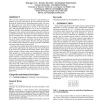Free Online Productivity Tools
i2Speak
i2Symbol
i2OCR
iTex2Img
iWeb2Print
iWeb2Shot
i2Type
iPdf2Split
iPdf2Merge
i2Bopomofo
i2Arabic
i2Style
i2Image
i2PDF
iLatex2Rtf
Sci2ools
ATAL
2010
Springer
2010
Springer
Stackelberg vs. Nash in security games: interchangeability, equivalence, and uniqueness
There has been significant recent interest in game theoretic approaches to security, with much of the recent research focused on utilizing the leader-follower Stackelberg game model; for example, these games are at the heart of major applications such as the ARMOR program deployed for security at the LAX airport since 2007 and the IRIS program in use by the US Federal Air Marshals (FAMS). The foundational assumption for using Stackelberg games is that security forces (leaders), acting first, commit to a randomized strategy; while their adversaries (followers) choose their best response after surveillance of this randomized strategy. Yet, in many situations, the followers may act without observation of the leader's strategy, essentially converting the game into a simultaneous-move game model. Previous work fails to address how a leader should compute her strategy given this fundamental uncertainty about the type of game faced. Focusing on the complex games that are directly inspir...
| Added | 08 Nov 2010 |
| Updated | 08 Nov 2010 |
| Type | Conference |
| Year | 2010 |
| Where | ATAL |
| Authors | Zhengyu Yin, Dmytro Korzhyk, Christopher Kiekintveld, Vincent Conitzer, Milind Tambe |
Comments (0)

